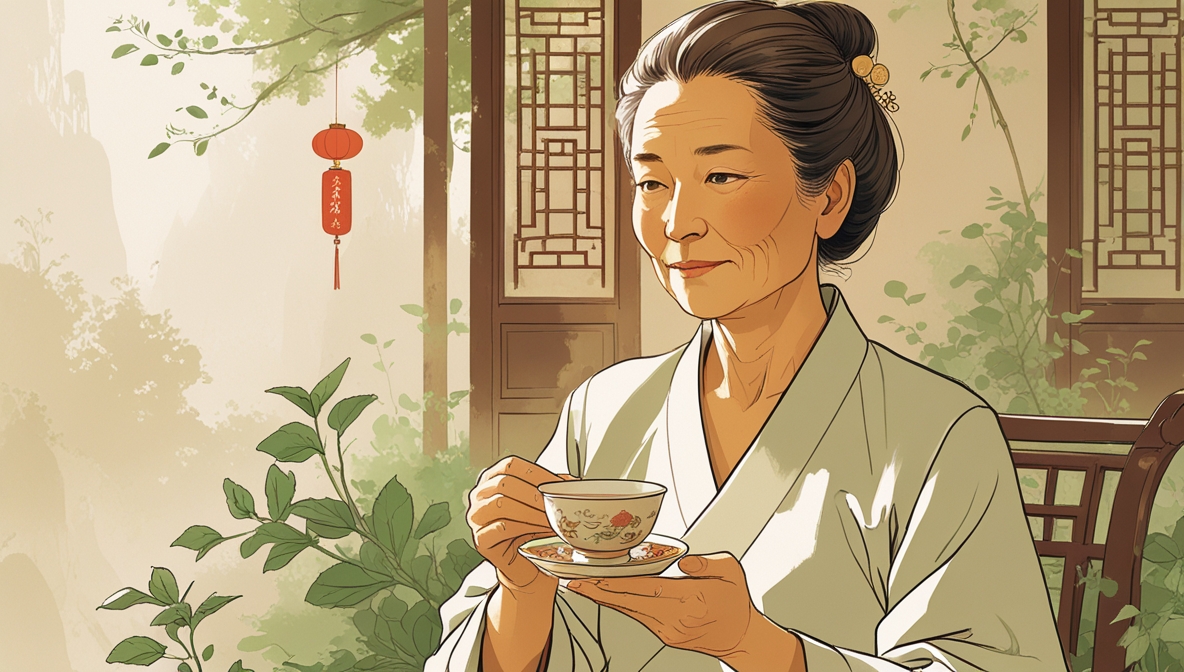Managing Hyperthyroidism and Rheumatoid Arthritis with Traditional Chinese Medicine

Hyperthyroidism and rheumatoid arthritis are two complex conditions that can drastically impact daily life. While hyperthyroidism affects the thyroid gland, leading to a variety of metabolic issues, rheumatoid arthritis attacks the joints, causing pain and inflammation. Traditional Chinese Medicine (TCM) offers a unique perspective in addressing these conditions, focusing on balance and the body’s natural healing mechanisms. By combining herbal remedies, acupuncture, and lifestyle adjustments, TCM aims to manage symptoms and improve overall well-being, offering hope for those seeking alternatives to conventional medicine.
Understanding Hyperthyroidism
Hyperthyroidism, often referred to as an overactive thyroid, occurs when your thyroid gland produces too much thyroid hormone. This condition affects various bodily functions, causing major disruptions in day-to-day life. Understanding its causes, symptoms, and diagnosis can help you take steps toward effective management.
Causes of Hyperthyroidism
Hyperthyroidism is most commonly triggered by autoimmune disorders, with Graves’ disease being the leading cause. In Graves’ disease, the immune system mistakenly attacks the thyroid gland, prompting it to create excessive hormones. Other potential causes include:
- Thyroid nodules, which are lumps in the thyroid that may independently produce hormones.
- Thyroiditis, or inflammation of the thyroid gland, sometimes caused by infection or other immune responses.
- Excess iodine intake, often from diet or supplements, which can overstimulate the thyroid.
- Medications, such as excessive thyroid hormone replacement therapy for hypothyroidism.
If you’d like to dive deeper into causes, this resource from the American Thyroid Association offers a comprehensive breakdown.
Symptoms of Hyperthyroidism
Hyperthyroidism symptoms vary but often include signs of an overactive metabolism. If you’ve noticed rapid, unexplained weight loss or sudden anxiety, your thyroid may be working overtime. Common symptoms include:
- Unintended weight loss, even when eating a normal or increased amount.
- Rapid or irregular heartbeat (tachycardia).
- Tremors, especially in hands and fingers.
- Sweating, often excessive and unrelated to physical activity.
- Fatigue or muscle weakness.
- Increased appetite alongside weight loss.
- Nervousness or irritability.
- Difficulty sleeping.
For a detailed symptom overview, check out this helpful guide by Cleveland Clinic.
Diagnosis of Hyperthyroidism
Accurate diagnosis often involves several steps. Your doctor will begin with a physical exam looking for enlarged thyroid glands or visible signs like tremors. Blood tests are a key diagnostic tool, measuring levels of:
- Thyroid-Stimulating Hormone (TSH): Low TSH often signals hyperthyroidism.
- Free Thyroxine (T4) and Triiodothyronine (T3): High levels confirm excess hormone production.
In some cases, imaging tests like a radioactive iodine uptake scan or ultrasound may be used to understand the gland’s function and structure. Learn more about testing protocols in this detailed resource by the AAFP.
Hyperthyroidism diagnosis and management require precise attention, as it significantly impacts metabolic and overall health. By identifying symptoms and understanding the diagnostic tools, you can work with your doctor to pursue the right path forward.
Understanding Rheumatoid Arthritis
Rheumatoid arthritis (RA) is a chronic autoimmune disorder that primarily affects the joints, leading to pain, swelling, and potential joint deformity. But it doesn’t stop there—it also can impact other parts of the body, including the skin, eyes, lungs, heart, and blood vessels. Unlike osteoarthritis, which results from wear and tear, RA occurs when the immune system mistakenly attacks your own tissues. To manage rheumatoid arthritis effectively, understanding its causes, symptoms, and diagnosis is key.
Causes of Rheumatoid Arthritis
What triggers rheumatoid arthritis? While the exact cause is still unclear, researchers believe it’s a mix of genetic, environmental, and immunological factors. Let’s break it down:
Genetics: If RA runs in your family, your risk may increase. Certain genes seem to make the immune system more likely to react inappropriately, leading to inflammation and joint damage. Learn more about genetic links here.
Environmental Factors: External influences like smoking, poor air quality, and certain infections might play a role in triggering RA in genetically predisposed individuals. Interestingly, smoking is one of the most well-documented environmental risks
Immune System Dysfunction: The immune system is supposed to protect against infections. In RA, it gets confused and begins attacking healthy cells, leading to inflammation and eventual tissue damage.
For a comprehensive overview of RA causes, check out this trusted resource by Mayo Clinic.
Symptoms and Diagnosis of Rheumatoid Arthritis
RA can be hard to identify early because its initial symptoms often resemble other ailments. Recognizing the signs and understanding diagnostic steps can be life-changing.
Common Symptoms Include:
- Joint Pain and swelling, typically affecting smaller joints like those in the hands and toes initially.
- Morning Stiffness lasting more than 30 minutes, making daily tasks difficult.
- Fatigue, fever, and unexplained weight loss, which are systemic symptoms of the disease.
- Symmetry: RA often affects joints symmetrically (both wrists, knees, etc.), which distinguishes it from other forms of arthritis.
For more details on symptoms, Cleveland Clinic offers a great summary.
Diagnosing Rheumatoid Arthritis:
Doctors use a combination of methods to diagnose RA. The process typically includes:
- Physical Examination: Checking for swollen, tender joints and evaluating joint mobility.
- Blood Tests, such as:
- Rheumatoid Factor (RF) Test: Detects antibodies linked to RA.
- Anti-CCP: A more specific indicator of rheumatoid arthritis.
- Erythrocyte Sedimentation Rate (ESR) or C-Reactive Protein (CRP): Identifies inflammation levels.
- Imaging Tests:
- X-rays, MRIs, or ultrasounds can help monitor joint damage and rule out other causes.
For an in-depth explanation of diagnostic procedures, visit this NIAMS resource.
Rheumatoid arthritis requires timely diagnosis and treatment to prevent irreversible joint damage and complications. Make sure you consult a healthcare provider if these symptoms seem familiar.
The Link Between Hyperthyroidism and Rheumatoid Arthritis
The connection between hyperthyroidism and rheumatoid arthritis (RA) stems from a shared feature: both are autoimmune disorders. These conditions occur when the body’s immune system—a natural defense against infections—goes rogue and attacks its own tissues. Understanding their relationship can provide valuable insights into managing them effectively, especially when using approaches like Traditional Chinese Medicine (TCM).
How Autoimmune Disorders Connect These Conditions
Autoimmune diseases often appear together due to similarities in their immunological triggers. For instance, in hyperthyroidism (commonly caused by Graves’ disease), the immune system produces antibodies that overstimulate the thyroid gland, leading to excessive thyroid hormone production. Similarly, in RA, immune system dysregulation results in the production of antibodies that target joint linings, causing inflammation and damage. This overlap is not just coincidental—research suggests a bidirectional association between RA and thyroid dysfunction.
According to a 2022 study, hyperthyroidism and RA can exacerbate each other if left untreated. The immune system’s mismanagement is the central thread linking these two diseases.
Shared Symptoms That May Be Overlooked
RA and hyperthyroidism often share symptoms that can make diagnosis tricky. Understanding these overlaps can prevent misdiagnosis or delayed treatment. Key symptoms that may be common to both include:
- Fatigue: A hallmark of both conditions, fatigue results from systemic inflammation in RA and increased metabolism in hyperthyroidism.
- Joint Pain: While joint pain is usually an RA-specific symptom, autoimmune activity in hyperthyroidism can occasionally trigger joint discomfort.
- Weight Changes: Hyperthyroidism often causes unexplained weight loss, while RA-related fatigue can result in weight gain due to reduced activity.
If you experience overlapping symptoms, it’s essential to consult with a healthcare provider to differentiate between the conditions. For more about their relationship, you can review this detailed overview.
Potential Mechanisms Behind the Link
Studies hypothesize several mechanisms that could explain why hyperthyroidism and RA often co-occur:
- Genetic Predisposition: Certain genes associated with immune system disorders may increase susceptibility to both conditions.
- Chronic Inflammation: RA’s systemic inflammation could influence thyroid function, either over-activating it or causing hypothyroidism later.
- Antibody Cross-Reactivity: Antibodies targeting one system may inadvertently attack another.
For example, research in the Frontiers in Endocrinology journal discusses how immune system imbalances fuel both RA and thyroid dysfunction, emphasizing the need for tailored treatment plans.
TCM Perspectives on Hyperthyroidism and RA Co-Occurrence
Traditional Chinese Medicine offers unique insights into the relationship between hyperthyroidism and rheumatoid arthritis. Both conditions are thought to arise from imbalances in vital energy (Qi), with excess “heat” commonly blamed for the inflammatory and overactive nature of these diseases. According to research on TCM for hyperthyroidism, herbal treatments and acupuncture target underlying systemic imbalances rather than just symptoms.
In cases where hyperthyroidism and RA occur together, TCM may focus on a combined approach to clear heat, reduce inflammation, and strengthen the body’s immune regulation. For example, therapies like Bu Zhong Yi Qi Tang (a common herbal prescription) help restore balance to boost energy and reduce inflammatory markers.
Understanding the link between hyperthyroidism and rheumatoid arthritis is crucial for informed treatment and symptom control. Their shared autoimmune origins and overlapping symptoms reinforce the importance of holistic management strategies, whether through conventional medicine or TCM.
Traditional Chinese Medicine: An Overview
Traditional Chinese Medicine (TCM) has been practiced for over 2,000 years, offering a holistic approach to health. It emphasizes the balance of Qi (pronounced “chee”), the body’s vital energy, circulating through pathways called meridians. When Qi is blocked or unbalanced, health issues arise. TCM aims to restore harmony using natural methods that address the body, mind, and spirit. Its foundational practices—herbal medicine, acupuncture, and dietary therapy—remain central to managing conditions like hyperthyroidism and rheumatoid arthritis.
Key Components of TCM: Herbs, Acupuncture, and Dietary Therapies
Herbal Medicine
One of TCM’s core practices is Chinese herbal medicine, which involves creating tailored formulations to address individual symptoms and underlying imbalances. Hundreds of plants and minerals are used, often combined to enhance their therapeutic effects. Herbs like Radix Bupleuri (Chai Hu) and Dang Gui are traditionally used for improving circulation, reducing inflammation, and supporting immune function. Such formulas can be adjusted for conditions like hyperthyroidism and rheumatoid arthritis, tackling not just the symptoms but the root cause.
Chinese herbal medicine has shown promise in managing autoimmune conditions. For example, studies suggest TCM herbs may help regulate inflammation and modulate immune response, essential for both managing rheumatoid arthritis and balancing thyroid function in hyperthyroidism. Learn more about Chinese herbal medicine from Better Health.
Acupuncture
Acupuncture involves inserting thin needles into specific meridian points to stimulate Qi flow and reduce blockages. It’s widely recognized for its ability to alleviate pain and promote relaxation, making it a powerful tool for conditions like rheumatoid arthritis, where inflammation and joint pain are prevalent.
In hyperthyroidism, acupuncture is thought to regulate the thyroid by balancing the Yin and Yang of bodily functions. Studies also highlight its role in reducing anxiety and improving sleep quality, which are often disrupted in hyperthyroidism. Acupuncture is an ancient yet scientifically-backed practice. For further insight, visit NCCIH’s guide on TCM.
Dietary Therapies
In TCM, food is not just sustenance—it’s medicine. Dietary therapies focus on incorporating foods that balance your body’s internal environment. For example:
- To tackle hyperthyroidism, cooling foods like cucumber, leafy greens, and seaweed may be recommended to balance excess heat.
- For rheumatoid arthritis, warm and anti-inflammatory foods such as ginger, turmeric, and bone broths are often included.
Additionally, TCM often advises avoiding “damp” foods like excessive dairy or sugar, which can exacerbate joint inflammation or thyroid issues. The personalized nature of these diets aligns well with TCM’s holistic framework, making it a key component of its approach.

Photo by Jefe King
By intertwining these practices, TCM creates a comprehensive system for managing conditions like hyperthyroidism and rheumatoid arthritis. Its focus on natural remedies and balance offers patients a unique path to overall well-being. Explore how TCM approaches rheumatoid arthritis and hyperthyroidism in greater detail at Mount Sinai.
TCM Approaches to Treat Hyperthyroidism
Hyperthyroidism, or an overactive thyroid, can be overwhelming to manage for those experiencing its effects. Traditional Chinese Medicine (TCM) offers alternative methods to balance the body and restore harmony by addressing the root cause of symptoms. Two primary approaches in TCM for dealing with hyperthyroidism include herbal remedies and acupuncture techniques. Here’s how they help:
Herbal Remedies in TCM: List commonly used herbs for managing hyperthyroidism
TCM herbal remedies focus on restoring equilibrium in the body. For hyperthyroidism, this often means clearing “heat” and “phlegm” associated with the overactivity of the thyroid gland. TCM practitioners carefully select herbs tailored to each individual, but several herbs are frequently employed:
- Xia Ku Cao (Prunella Vulgaris): Known as “selfheal spike,” this herb cools and detoxifies the body, addressing swelling and nodules that may accompany hyperthyroid conditions.
- Sheng Di Huang (Rehmannia Root): This herb nourishes Yin energy, counteracting the fire-like heat that can fuel hyperthyroidism.
- Chai Hu (Bupleurum): Often used for liver health, this herb mitigates stress and anxiety, which can exacerbate thyroid issues.
- Dang Gui (Angelica Sinensis): Known for promoting blood circulation, it can support overall energy balance.
- Mu Dan Pi (Moutan Cortex): This is another cooling herb for clearing heat.
These herbs are commonly formulated into personalized prescriptions designed to treat the individual’s unique symptoms. For more specifics, check out research detailing herbal approaches to managing thyroid health, which highlights the benefits of integrating TCM herbs into comprehensive treatment.
Acupuncture Techniques: Explain how acupuncture can assist in treatment
Acupuncture is one of the cornerstone practices in TCM, aimed at balancing the flow of Qi (energy) through key meridians in your body. In hyperthyroidism treatment, acupuncture not only targets the thyroid gland but also helps regulate the endocrine system and reduce systemic inflammation.
How does acupuncture help hyperthyroidism?
- Balancing Yin and Yang: Acupuncture addresses the imbalance between Yin (cooling energy) and Yang (heating energy), which often manifests in symptoms like irritability and rapid heartbeat.
- Calming the Nervous System: Specific points, such as those along the Liver and Spleen channels, promote relaxation and reduce stress-related overstimulation of the thyroid gland.
- Supporting Blood and Energy Flow: Boosting circulation aids in removing heat and phlegm blockages, which TCM identifies as contributors to hyperthyroidism symptoms.
Studies also underline its effectiveness, with one report showcasing how acupuncture can outperform pharmaceuticals in managing certain thyroid conditions. To learn more, visit HealthCMi’s coverage on acupuncture for hyperthyroidism.

Photo by Antoni Shkraba
Acupuncture and TCM herbal treatments are often integrated to create a complementary approach, addressing not just the symptoms but the systemic imbalances that drive hyperthyroidism.
TCM Approaches to Treat Rheumatoid Arthritis
Traditional Chinese Medicine (TCM) presents a comprehensive view of health and wellness to address rheumatoid arthritis (RA). By focusing on rebalancing the body’s Qi (vital energy) and resolving underlying imbalances like “dampness” or “heat,” TCM integrates treatment methods that emphasize herbal remedies and dietary practices. These approaches target not only the symptoms of RA but also its root causes, making it an appealing option for chronic disease management.
Herbal Remedies for Rheumatoid Arthritis
One of the key components of TCM for RA includes the use of herbal remedies. These remedies often comprise various herbs combined into tailored formulations designed to alleviate pain, reduce inflammation, and strengthen the immune system. Here are some commonly used herbs in TCM for RA:
- Tripterygium wilfordii (Thunder God Vine): Known for its potent anti-inflammatory properties, this herb is frequently used to relieve joint pain and swelling. Learn more about its effects here.
- Gui Zhi (Cinnamon Twig): Often included in prescriptions to improve circulation and reduce stiffness.
- Dang Gui (Angelica Sinensis): Regularly used to nourish the blood and alleviate chronic inflammation in RA patients.
- Qiang Huo (Notopterygium Root): This herb targets “dampness” in TCM, easing joint stiffness, especially during cold weather.
- Wu Jia Pi (Acanthopanax Bark): Used to strengthen tendons and bones while relieving joint pain.
- Fang Feng (Saposhnikovia Root): Known for dispelling wind and dampness, two key elements believed to exacerbate RA symptoms in TCM.
Research supports the efficacy of TCM herbs in reducing inflammation and promoting joint repair. For example, studies on Chinese herbal medicines like Guizhi-Shaoyao-Zhimu decoction have shown promise in managing active RA. Explore detailed insights from this study.
Dietary Considerations in TCM
TCM recognizes the significant impact of diet on chronic inflammatory conditions like RA. Maintaining a balanced and personalized dietary regimen is often regarded as equally important as medicinal treatments. TCM dietary practices are based on eliminating “dampness” and “cold” while strengthening the body’s ability to combat inflammation.
Foods to Include
- Warming Foods: Ginger, garlic, and cinnamon add “warmth” and promote circulation.
- Anti-inflammatory Options: Leafy greens, sweet potatoes, and turmeric reduce systemic inflammation.
- Bone Broths: Rich in collagen and nutrients, they help improve joint health.
- Citrus Fruits: Oranges and lemons bring a cooling but invigorating balance.
Foods to Avoid
- Dairy Products: These are thought to create dampness, exacerbating joint pain.
- Cold Foods and Drinks: Ice-cold beverages or salads are often avoided to prevent stagnation.
- Processed Sugary Snacks: These are believed to increase inflammation levels.
Interestingly, some TCM practitioners recommend incorporating principles of the Mediterranean diet due to its alignment with anti-inflammatory goals. This includes a focus on fish, nuts, and olive oil. Learn how the Mediterranean diet supports RA management.
By combining an anti-inflammatory diet with TCM herbal treatments, patients often experience more effective symptom control and improved quality of life. Traditional Chinese Medicine demonstrates that RA management doesn’t just have to involve pills and injections—it can also embrace natural, holistic solutions.
Integrating TCM with Conventional Treatment
Integrating Traditional Chinese Medicine (TCM) with conventional treatment offers a promising blend of modern science and ancient wisdom for managing both hyperthyroidism and rheumatoid arthritis. Combining these approaches can address symptoms holistically, targeting both immediate issues and underlying imbalances. Here’s how the integration works and its potential benefits.
How TCM Complements Conventional Medicine
Conventional medical treatments focus on directly addressing the symptoms and progression of diseases like hyperthyroidism and rheumatoid arthritis. TCM, on the other hand, prioritizes balancing the body’s energy systems (Qi) and treating the root cause of symptoms. Together, they create a well-rounded strategy.
Key ways TCM complements modern medicine:
- Symptom Relief: Practices like acupuncture can reduce joint pain and stress while managing hyperthyroid symptoms like anxiety and insomnia.
- Lower Drug Dependency: Herbal remedies may reduce the need for high doses of conventional medications, minimizing side effects.
- Enhanced Healing: Combining TCM’s systemic balancing techniques with targeted pharmaceuticals can lead to quicker and more sustained recovery.
For example, studies suggest that integrating Qingre Huoxue treatments with standard rheumatoid arthritis therapies can significantly improve patient outcomes and reduce inflammation (source).
Methods of Integration
The integration process typically involves a coordinated plan between TCM practitioners and conventional healthcare providers. Here are some common methods:
Dual Use of Acupuncture and Medication:
- Acupuncture can relieve inflammation and joint pain without interfering with anti-inflammatory drugs. For hyperthyroidism, it works to rebalance the thyroid’s energy pathways.
Herbal Medicines Alongside Pharmaceuticals:
- TCM herbs like Rehmannia Root or Thunder God Vine are often used with prescription drugs. For example, studies show synergistic effects when TCM herbal treatments are combined with thyroid-stimulating hormone (TSH) regulation (source).
Guided Lifestyle Adjustments:
- Dietary therapies in TCM, such as consuming cooling foods for hyperthyroidism or warming spices for rheumatoid arthritis, complement conventional dietary advice for inflammation control.
Benefits Backed by Research
Recent clinical studies emphasize the advantages of an integrative approach:
- A 2020 meta-analysis highlighted the safety and efficacy of integrating TCM and Western medicine for rheumatoid arthritis management. Patients experienced better mobility and reduced flare-ups (source).
- Similarly, research on Graves’ hyperthyroidism discussed the positive impacts of TCM in maintaining thyroid hormone balance and lowering antibody levels (source).
Practical Considerations for Successful Integration
Effective integration requires careful coordination and open communication between healthcare providers and patients. Consider these factors:
- Start With Consultation: Always consult your healthcare provider before adding TCM practices to your treatment regime. A tailored approach ensures no conflicts with existing medications.
- Monitor Consistently: Regular check-ups are vital to evaluate progress and adjust either TCM strategies or medicinal dosages as needed.
- Find Certified Practitioners: Only work with licensed TCM professionals who understand how to navigate both holistic and clinical therapies.
Combining TCM with Western medicine isn’t about choosing one over the other; it’s about creating a treatment plan that draws on the strengths of each for better health outcomes.
Key Takeaways
When addressing complex conditions like hyperthyroidism and rheumatoid arthritis (RA) through Traditional Chinese Medicine (TCM), it’s important to focus on individual symptoms and the roots of these ailments. This section provides a summary of the most important points for understanding and treating these autoimmune diseases using TCM.
The Connection Between Hyperthyroidism and Rheumatoid Arthritis
- Both hyperthyroidism and RA are autoimmune conditions involving an overactive immune system attacking the body’s tissues.
- There’s a potential causal relationship, as studies suggest overlapping risk factors and mechanisms between the two (source).
- Shared symptoms, like fatigue and inflammation, can blur the diagnostic process, making personalized treatment essential.
TCM’s Holistic Approach to Autoimmune Disorders
- Traditional Chinese Medicine emphasizes balancing the body’s energy (Qi) and addressing systemic imbalances.
- Herbal remedies, acupuncture, and dietary adjustments are core methods in managing autoimmune conditions.
- By treating the root cause, TCM offers a unique advantage over conventional one-size-fits-all treatments (source).
Benefits of Herbal Medicine
- Herbs like Xia Ku Cao and Dang Gui reduce “heat” and inflammation, improving symptoms of hyperthyroidism and RA.
- Balanced formulations target both symptoms and underlying immune dysfunction (source).
Role of Acupuncture
- Acupuncture helps regulate hormonal activity, alleviate joint pain, and reduce stress-related triggers for thyroid and joint dysfunction (source).
- Proven to complement medication by easing systemic inflammation and improving overall well-being.
Integration of TCM and Modern Treatments
- Combining methods allows for efficient management of symptoms while reducing drug dependency.
- Studies highlight the success of integrating TCM with pharmacological treatments, offering comprehensive care for both hyperthyroidism and RA (source).
Tailored Dietary Adjustments in TCM
- Cooling foods like cucumber help regulate hyperthyroidism, while warming foods like ginger ease RA inflammation.
- Avoiding damp or processed foods aligns with TCM’s holistic dietary framework to support healing.
These key takeaways underscore the interconnectedness of hyperthyroidism and RA, as well as the integrative potential of TCM and conventional therapies. Adopting TCM principles could provide a more balanced and personalized approach to managing these conditions.
Conclusion
Exploring the potential of Traditional Chinese Medicine (TCM) for managing hyperthyroidism and rheumatoid arthritis offers a fresh perspective on autoimmune care. TCM’s holistic methods, including herbal remedies, acupuncture, and dietary therapies, aim to balance underlying imbalances rather than just treating symptoms.
For individuals facing these conditions, integration of TCM with conventional medical approaches could lead to more comprehensive care. It’s a promising way to reduce inflammation, regulate immune responses, and manage overlapping symptoms effectively.
Always consult your healthcare provider before trying new treatments to ensure safety and alignment with your medical needs. Combining modern medicine with TCM might just be the key to improving your quality of life naturally and sustainably.





